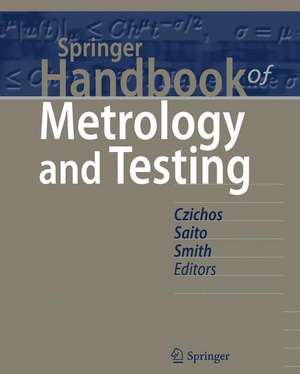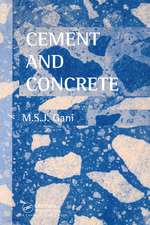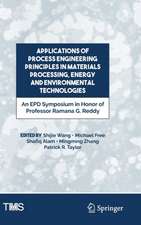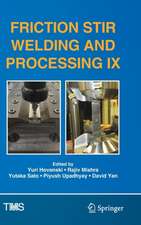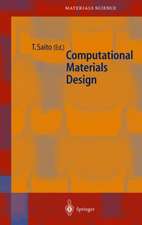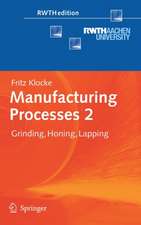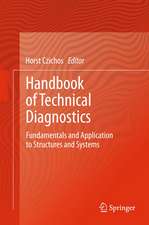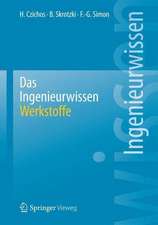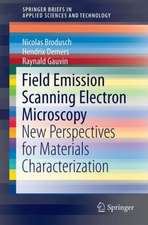Springer Handbook of Metrology and Testing: Springer Handbooks
Editat de Horst Czichos, Tetsuya Saito, Leslie E. Smithen Limba Engleză Hardback – 22 iul 2011
The principal motivation for this Handbook stems from the increasing demands of technology for measurement results that can be used globally. Measurements within a local laboratory or manufacturing facility must be able to be reproduced accurately anywhere in the world.
The book integrates knowledge from basic sciences and engineering disciplines, compiled by experts from internationally known metrology and testing institutions, and academe, as well as from industry, and conformity-assessment and accreditation bodies.
The Commission of the European Union has expressed this as there is no science without measurements, no quality without testing, and no global markets without standards.
Din seria Springer Handbooks
- 18%
 Preț: 1906.89 lei
Preț: 1906.89 lei - 18%
 Preț: 1913.72 lei
Preț: 1913.72 lei - 18%
 Preț: 2098.08 lei
Preț: 2098.08 lei - 18%
 Preț: 2763.66 lei
Preț: 2763.66 lei - 18%
 Preț: 1916.75 lei
Preț: 1916.75 lei - 18%
 Preț: 1847.57 lei
Preț: 1847.57 lei - 18%
 Preț: 2199.71 lei
Preț: 2199.71 lei - 18%
 Preț: 2490.71 lei
Preț: 2490.71 lei - 18%
 Preț: 2110.83 lei
Preț: 2110.83 lei - 18%
 Preț: 2299.02 lei
Preț: 2299.02 lei - 18%
 Preț: 2113.87 lei
Preț: 2113.87 lei - 18%
 Preț: 2098.70 lei
Preț: 2098.70 lei - 18%
 Preț: 2975.34 lei
Preț: 2975.34 lei - 18%
 Preț: 2097.19 lei
Preț: 2097.19 lei - 18%
 Preț: 1929.01 lei
Preț: 1929.01 lei - 20%
 Preț: 2267.39 lei
Preț: 2267.39 lei - 18%
 Preț: 2484.66 lei
Preț: 2484.66 lei - 18%
 Preț: 1681.71 lei
Preț: 1681.71 lei - 18%
 Preț: 1650.73 lei
Preț: 1650.73 lei - 18%
 Preț: 1932.50 lei
Preț: 1932.50 lei - 18%
 Preț: 2092.64 lei
Preț: 2092.64 lei - 23%
 Preț: 2125.54 lei
Preț: 2125.54 lei - 18%
 Preț: 2092.64 lei
Preț: 2092.64 lei - 20%
 Preț: 2005.94 lei
Preț: 2005.94 lei - 18%
 Preț: 2449.79 lei
Preț: 2449.79 lei - 18%
 Preț: 2128.28 lei
Preț: 2128.28 lei - 18%
 Preț: 1931.17 lei
Preț: 1931.17 lei - 18%
 Preț: 2088.83 lei
Preț: 2088.83 lei - 20%
 Preț: 2023.06 lei
Preț: 2023.06 lei - 18%
 Preț: 2477.84 lei
Preț: 2477.84 lei - 18%
 Preț: 2092.64 lei
Preț: 2092.64 lei - 18%
 Preț: 1947.94 lei
Preț: 1947.94 lei - 18%
 Preț: 2464.93 lei
Preț: 2464.93 lei - 23%
 Preț: 2336.49 lei
Preț: 2336.49 lei - 23%
 Preț: 2224.43 lei
Preț: 2224.43 lei - 23%
 Preț: 2352.57 lei
Preț: 2352.57 lei - 23%
 Preț: 1704.69 lei
Preț: 1704.69 lei - 23%
 Preț: 1722.68 lei
Preț: 1722.68 lei - 23%
 Preț: 1991.86 lei
Preț: 1991.86 lei - 14%
 Preț: 1324.03 lei
Preț: 1324.03 lei - 14%
 Preț: 1324.03 lei
Preț: 1324.03 lei - 34%
 Preț: 1734.73 lei
Preț: 1734.73 lei - 14%
 Preț: 1324.03 lei
Preț: 1324.03 lei - 29%
 Preț: 1584.55 lei
Preț: 1584.55 lei
Preț: 1924.34 lei
Preț vechi: 2346.76 lei
-18% Nou
Puncte Express: 2887
Preț estimativ în valută:
340.47€ • 396.65$ • 297.31£
340.47€ • 396.65$ • 297.31£
Carte disponibilă
Livrare economică 29 decembrie 25 - 12 ianuarie 26
Preluare comenzi: 021 569.72.76
Specificații
ISBN-13: 9783642166402
ISBN-10: 3642166407
Pagini: 1500
Ilustrații: MCCXXXII, 32 p.
Dimensiuni: 193 x 242 x 61 mm
Greutate: 2.65 kg
Ediția:2nd ed. 2011
Editura: Springer Berlin, Heidelberg
Colecția Springer
Seria Springer Handbooks
Locul publicării:Berlin, Heidelberg, Germany
ISBN-10: 3642166407
Pagini: 1500
Ilustrații: MCCXXXII, 32 p.
Dimensiuni: 193 x 242 x 61 mm
Greutate: 2.65 kg
Ediția:2nd ed. 2011
Editura: Springer Berlin, Heidelberg
Colecția Springer
Seria Springer Handbooks
Locul publicării:Berlin, Heidelberg, Germany
Public țintă
Professional/practitionerCuprins
This Springer Handbook of Metrology and Testing is a comprehensive treatise of Metrology, the science of measurement, and of Testing, the technical procedure of determining characteristics of a given object, product or process. The Handbook is organized in five parts.
Part A: Fundamentals of Metrology and Testing
Part B: Chemical and Microstructural Analysis
Part C: Materials Properties Measurement
Part D: Materials Performance Testing
Part E: Modeling and Simulation Methods
About the Authors
Subject Index
Notă biografică
Dr. Horst Czichos has been President of BAM, the German Federal Institute for Materials Research and Testing (1992-2002) and President of EUROLAB, the European Federation of National Associations of Measurement, Testing and Analytical Laboratories (1999-2003). He holds degrees in precision engineering, physics and materials science from the Free University and the Technical University of Berlin, and obtained a Dr. h.c. from KU Leuven University for his research work in tribology. He is currently Professor of Mechatronics at the University of Applied Sciences, BHT Berlin, and received 2007 the Beuth Award for achievement in engineering education.
Dr. Saito is currently Senior Adviser Emeritus at the National Institute for Materials Science (NIMS) and has served as Chair of ISO/TC164 (Mechanical Testing of Metals) for nine years. He received his Dr.-Eng from the University of Tokyo in 1978 and since has held various positions at the National Research Institute forMetals, including Director of Materials Evaluation Division and Deputy Director-General of the Institute.
After retirement from his position as Director of the Materials Science and Engineering Laboratory of the National Institute of Standards and Technology (NIST) Dr. Leslie Smith is a Research Associate at NIST. He received B.S. and Ph.D. degrees from Case Institute of Technology and the Catholic University of America in physical-organic chemistry and conducted research primarily on the adsorption of polymers and the degradation of polyesters.
Dr. Saito is currently Senior Adviser Emeritus at the National Institute for Materials Science (NIMS) and has served as Chair of ISO/TC164 (Mechanical Testing of Metals) for nine years. He received his Dr.-Eng from the University of Tokyo in 1978 and since has held various positions at the National Research Institute forMetals, including Director of Materials Evaluation Division and Deputy Director-General of the Institute.
After retirement from his position as Director of the Materials Science and Engineering Laboratory of the National Institute of Standards and Technology (NIST) Dr. Leslie Smith is a Research Associate at NIST. He received B.S. and Ph.D. degrees from Case Institute of Technology and the Catholic University of America in physical-organic chemistry and conducted research primarily on the adsorption of polymers and the degradation of polyesters.
Textul de pe ultima copertă
This Springer Handbook of Metrology and Testing presents the principles of Metrology – the science of measurement – and the methods and techniques of Testing – determining the characteristics of a given product – as they apply to chemical and microstructural analysis, and to the measurement and testing of materials properties and performance, including modelling and simulation.
The principal motivation for this Handbook stems from the increasing demands of technology for measurement results that can be used globally. Measurements within a local laboratory or manufacturing facility must be able to be reproduced accurately anywhere in the world. The Commission of the European Union has expressed this as follows:
There is no science without measurements, no quality without testing, and no global markets without standards.
The Handbook is organized in five parts. Part A: Fundamentals of Metrology and Testing. Part B: Chemical and Microstructural Analysis. Part C: Materials Properties Measurement. Part D: Materials Performance Testing. Part E: Modeling and Simulation Methods.
Key Topics
Metrology Principles and Organization
Methodologies of Measurement and Testing
Analytical Chemistry Methods
Microstructural and Nanoscopic Analyses
Materials Properties Measurement: mechanical, thermal, lectrical, magnetic, optical
Materials Performance Testing: Corrosion, friction and wear, biogenic, environmental
Nondestructive Testing
Reliability Evaluation
Modeling and Simulation Methods: molecular dynamics simulation, finite element methods, Monte Carlo simulation
Features
Develops and explains guidelines and standards for Quality of Measurement and Testing
Sampling
Traceability of Measurement and Testing
Statistical Evaluation of Results
Accuracy and Uncertainty of Measurement
Validation
Inter-laboratory Comparisons and Proficiency Testing
Reference Materials
Reference Procedures
Human Aspects in a Laboratory
International Standards, Laboratory Accreditation and Global Trade
The principal motivation for this Handbook stems from the increasing demands of technology for measurement results that can be used globally. Measurements within a local laboratory or manufacturing facility must be able to be reproduced accurately anywhere in the world. The Commission of the European Union has expressed this as follows:
There is no science without measurements, no quality without testing, and no global markets without standards.
The Handbook is organized in five parts. Part A: Fundamentals of Metrology and Testing. Part B: Chemical and Microstructural Analysis. Part C: Materials Properties Measurement. Part D: Materials Performance Testing. Part E: Modeling and Simulation Methods.
Key Topics
Metrology Principles and Organization
Methodologies of Measurement and Testing
Analytical Chemistry Methods
Microstructural and Nanoscopic Analyses
Materials Properties Measurement: mechanical, thermal, lectrical, magnetic, optical
Materials Performance Testing: Corrosion, friction and wear, biogenic, environmental
Nondestructive Testing
Reliability Evaluation
Modeling and Simulation Methods: molecular dynamics simulation, finite element methods, Monte Carlo simulation
Features
Develops and explains guidelines and standards for Quality of Measurement and Testing
Sampling
Traceability of Measurement and Testing
Statistical Evaluation of Results
Accuracy and Uncertainty of Measurement
Validation
Inter-laboratory Comparisons and Proficiency Testing
Reference Materials
Reference Procedures
Human Aspects in a Laboratory
International Standards, Laboratory Accreditation and Global Trade
Caracteristici
Offers advanced methods for materials measurement and characterization from the macroscopic to the nanometer scale Special emphasis on test procedures Includes extensive references to primary data sources Delivers a wealth of up-to-date references Includes supplementary material: sn.pub/extras
